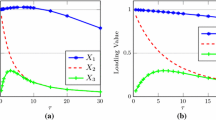Abstract
This paper studies the pricing behaviors of default-free bonds based on the two-factor model by Brennan and Schwartz (1979), where a short-term spot rate and a long-term consol rate are the state variables. The logarithm of these two factors is assumed to follow a linear transformation of an Ornstein-Uhlenbeck process. An exact discrete time model is derived to estimate the parameters in the process. The model prices are then numerically solved. The sensitivity analysis indicates that the long-rate process, especially the long-rate volatility parameter, is important in characterizing the term structure of interest rates.
Similar content being viewed by others
References
Arnold, L.,Stochastic Differential Equations: Theory and Applications. New York: John Wiley & Sons, 1974.
Brennan, M.J. and E.S. Schwartz, “Savings Bonds, Retractable Bonds, and Callable Bonds.”Journal of Financial Economics 18, 373–399, (1977).
Brennan, M.J. and E.S. Schwartz, “A Continuous Time Approach to the Pricing of Bonds.”Journal of Banking and Finance 3, 133–155, (1979).
Brennan, M.J. and E.S. Schwartz, “An Equilibrium Model of Bond Pricing and a Test of Market Efficiency.”Journal of Financial and Quantitative Analysis 17, 301–329, (1982).
Brown, S.J. and P.H. Dybvig, “The Empirical Implications of the Cox, Ingersoll, Ross Theory of the Term Structure of Interest Rates.”Journal of Finance 41, 617–630, (1986).
Chen, R.R. and L.O. Scott, “Maximum Likelihood Estimation of a Multi-Factor Equilibrium Model of the Term Structure of Interest Rates.” Working paper, University of Georgia, (1991).
Chen, R.R. and L.O. Scott, “Pricing Interest Rate Options in a Two-Factor Cox-Ingersoll-Ross Model of the Term Structure.”The Review of Financial Studies 5, 613–636, (1992).
Constantinides, G.M., “A Theory of the Nominal Term Structure of Interest Rates.”The Review of Financial Studies 5, 531–552, (1992).
Cox, D.D., “Gaussian Likelihood Estimation for Nearly Nonstationary AR(1) Processes.” Department of Statistics, GN-22, University of Washington, (1987).
Cox, J., J. Ingersoll, and S. Ross, “A Theory of the Term Structure of Interest Rates.”Econometrica 53, 385–407, (1985).
Dietrich-Campbell, and E. Schwartz, “Valuing Debt Options: Empirical Evidence.”Journal of Financial Economics 16, 321–343, (1986).
Dothan, U.L., “On the Term Structure of Interest Rates.”Journal of Financial Economics 6, 59–69, (1978).
Duffie, D. and K.J. Singleton, “Simulated Moments Estimation of Diffusion Models of Asset Prices.” Graduate School of Business, Stanford University, (1988).
Dybvig, P.H., “Bond and Bond Option Pricing Based on the Current Term Structure.” Working paper, Washington University, St. Louis, (1989).
Gibbons, M.R. and K. Ramaswamy, “The Term Structure of Interest Rates: Empirical Evidence.” Working paper, Stanford University, (1992).
Gourlay, A.R. and S. McKee, “The Construction of Hopscotch Methods for Parabolic and Elliptic Equations in Two Space Dimensions with a Mixed Derivative.”Journal of Computational and Applied Mathematics 3, 201–206, (1977).
Hansen, L.F., “Large Sample Properties of Generalized Method of Moments Estimators.”Econometrica 50, 1029–1054, (1982).
Heston, S., “Testing Continuous-Time Models of the Term Structure of Interest Rates.” School of Organization and Management, Yale University, (1991).
Longstaff, F. and E.S. Schwartz, “Interest Rate Volatility and the Term Structure: A Two-Factor General Equilibrium Model.”Journal of Finance 47, 1259–1282, (1992).
Marsh, T., “Equilibrium Term Structure Models: Test Methodology.”Journal of Finance 35, 421–435, (1980).
Marsh and Rosenfeld, “Stochastic Processes for Interest Rates and Equilibrium Bond Prices.”Journal of Finance 38, 635–646, (1983).
Oldfield, G.S. and R.J. Rogalski, “The Stochastic Properties of Term Structure Movements.”Journal of Monetary Economics 19, 229–254, (1987).
Pearson, N.D. and T. Sun, “An Empirical Examination of the Cox, Ingersoll, Ross Model, of the Term Structure of Interest Rates Using the Method of Maximum Likelihood.” Working paper, University of Rochester and Columbia University, (1991).
Pennacchi, G.G., “Identifying the Dynamics of Real Interest Rates and Inflation: Evidence Using Survey Data.”Review of Financial Studies 4, 53–86, (1991).
Phillips, P.C.B., “The Structural Estimation of a Stochastic Differential Equation System.”Econometrica 40, 1021–1041, (1972).
Schaefer, S.M. and E.S. Schwartz, “A Two-Factor Model of the Term Structure: An Approximation Analytical Solution.”Journal of Financial and Quantitative Analysis 19, 413–424, (1984).
Schaefer, S.M. and E.S. Schwartz, “Time-Dependent Variance and the Pricing of Bond Options.”Journal of Finance 42, 1113–1128, (1987).
Scott, L.O., “Option Pricing when the Variance Changes Randomly: Theory, Estimation and an Application.”Journal of Financial and Quantitative Analysis 22, 419–438, (1987).
Smith, G.D.,Numerical Solution of Partial Differential Equations: Finite Difference Methods 3rd Ed. Oxford, U.K.: Clarendon Press, 1985.
Sun, T., “Real and Nominal Interest Rates: A Discrete-Time Model and Its Continuous-Time Limit.”Review of Financial Studies 5, 581–611, (1992).
Vasicek, O.A., “An Equilibrium Characterization of the Term Structure.”Journal of Financial Economics 5, 177–178, (1977).
Author information
Authors and Affiliations
Rights and permissions
About this article
Cite this article
Hsin, CW. An empirical investigation of the two-factor Brennan-Schwartz term structure model. Rev Quant Finan Acc 5, 71–92 (1995). https://doi.org/10.1007/BF01074853
Issue Date:
DOI: https://doi.org/10.1007/BF01074853




